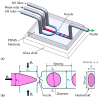Modeling of Droplet Generation in a Microfluidic Flow-Focusing Junction for Droplet Size Control
- PMID: 34063839
- PMCID: PMC8223991
- DOI: 10.3390/mi12060590
Modeling of Droplet Generation in a Microfluidic Flow-Focusing Junction for Droplet Size Control
Abstract
In this paper, we study the parameters that affect the generation of droplets in a microfluidic flow-focusing junction. Droplets are evaluated based on the size and frequency of generation. Droplet size control is essential for microfluidic lab-on-a-chip applications in biology, chemistry, and medicine. We developed a three-dimensional numerical model that can emulate the performance of the physical system. A numerical model can help design droplet-generation chips with new junction geometries, different dispersed and continuous phase types, and different flow rates. Our model uses a conservative level-set method (LSM) to track the interface between two immiscible fluids using a fixed mesh. Water was used for the dispersed phase and mineral oil for the continuous phase. The effects of the continuous-to-dispersed flow rate ratio (Qo/Qw) and the surfactant concentration on the droplet generation were studied both using the numerical model and experimentally. The numerical model was found to render results that are in good agreement with the experimental ones, which validates the LSM model. The validated numerical model was used to study the time effect of changing Qo/Qw on the generated droplet size. Properly timing when the flow rates are changed enables control over the size of the next generated droplet, which is useful for single-droplet size modulation applications.
Keywords: droplet generation; droplet modulation; emulsions; microfluidics.
Conflict of interest statement
The authors declare no conflict of interest.
Figures








References
Grants and funding
LinkOut - more resources
Full Text Sources
Miscellaneous

